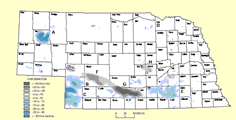Natural Resources, School of

Conservation and Survey Division: Faculty and Staff Publications
Document Type
Article
Date of this Version
Fall 2022
Citation
Great Plains Research 32 (Fall 2022):95–133.
DOI: 10.1353/gpr.2022.0010
Abstract
Understanding soil systems that characterize a region is critical to natural resource management. However, the knowledge gained through intensive study of local soil systems, which takes place annually as part of collegiate soil judging contests, is often poorly preserved for future use. In this study, field descriptions and laboratory data for 16 soil profiles described for the 2019 Region 5 Soil Judging Contest were used to characterize the soil system of the Central Nebraska Loess Hills and Central Loess Plains. Three landscape components of this soil system were analyzed: the loess uplands and rainwater basins, the transitional zone, and bottomlands. Rainwater basins exhibit increasing clay, clay films, and melanization compared to surrounding uplands. The transitional zone between the upland and bottomlands exhibits fining and aging of parent material with increasing elevation, resulting in increased prevalence of clay films, lower pH relative to parent material, and melanization. The bottomlands exhibited subtle variations in texture of the alluvium resulting in differences in expression of melanization, effervescence, pH, and redoximorphic features. Patterns observed within this soil system are well explained by existing pedogenic theories and demonstrate the unique interplay between soil-forming factors characteristic of this region of the Great Plains.
Included in
Geology Commons, Geomorphology Commons, Hydrology Commons, Paleontology Commons, Sedimentology Commons, Soil Science Commons, Stratigraphy Commons


Comments
Copyright © 2023 by the Center for Great Plains Studies, University of Nebraska–Lincoln